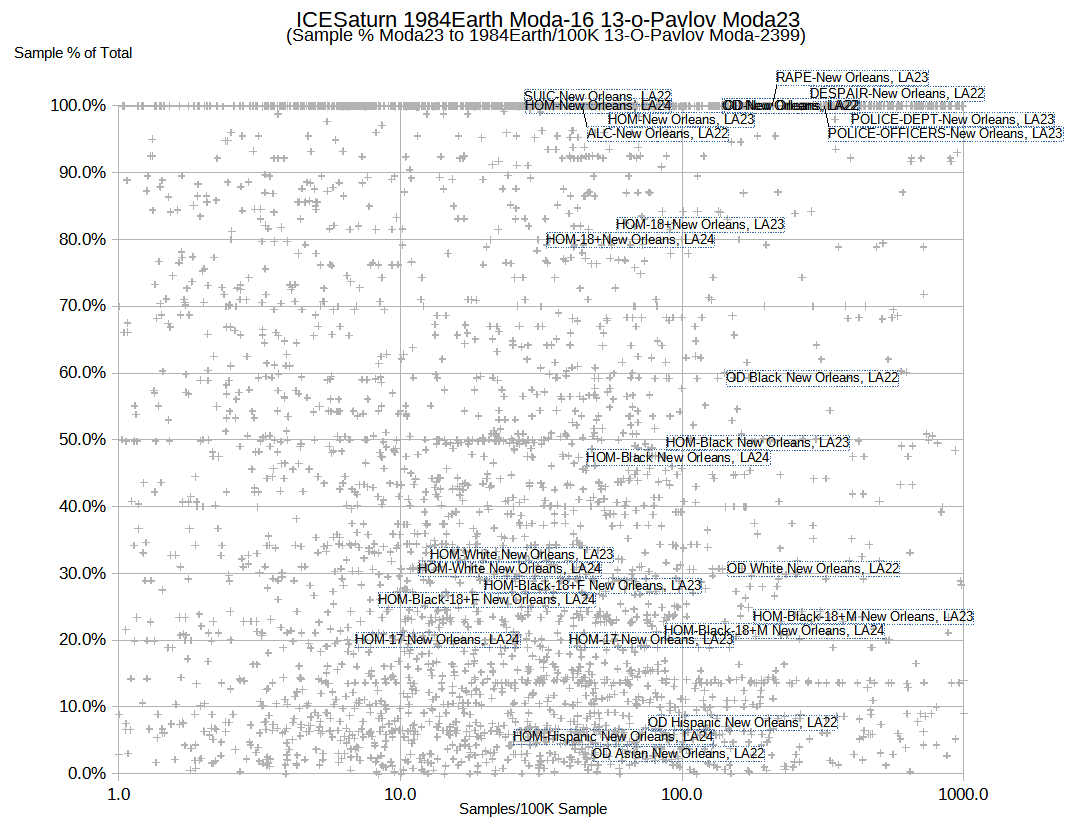
Where Roulet discovered Why Nazis, in 1984, New Orleans leads the decline in violent crime across the nation. Here's what changed -- an expanding array of powerful lenses, police drones, and a few hundred vehicle license-plate readers -- has facilitated an increase in arrests large and small, police say. The rate of arrests for shootings and murders also has risen, city data show.
New Orleans leads the decline in violent crime across the nation. Here's what changed.
From a cupola crowning the historic Cabildo on Jackson Square, with a postcard view of cathedral spires and the New Orleans skyline, Sgt. Lanc…
- BY MISSY WILKINSON AND JOHN SIMERMAN | Staff writer
- Oct 13, 2024
From a cupola crowning the historic Cabildo on Jackson Square, with a postcard view of cathedral spires and the New Orleans skyline, Sgt. Lance Lavigne piloted a Louisiana State Police drone Wednesday across the French Quarter.
His cracked, peeling skin is testament to the months he's spent in sunny perches, he said, birddogging crime from New Orleans East to Uptown.
“We try to get high. Because when you get high, you can get a good line of sight,” Lavigne said.
Lavigne was on the hunt Wednesday for drug deals in the Vieux Carre. A few floors below him, in a substation on the site of a Spanish colonial jail, fellow troopers watched the drone’s live feed. They homed on a man they suspected was doing a drug deal on Royal Street. In a few moments, troopers on the street moved in to cuff him, while streams of visitors walked by, seeming oblivious to the arrest.
“What you’re seeing here can play out dozens of times per day,” said Bryan LaGarde, director of the nonprofit Project NOLA, which has provided its high-tech network of private cameras for the effort.
The technology that now blankets the French Quarter and stretches across the city -- an expanding array of powerful lenses, police drones, and a few hundred vehicle license-plate readers--has facilitated an increase in arrests large and small, police say. The rate of arrests for shootings and murders also has risen, city data show.
It's a flashy component to what law enforcement, health officials and other stakeholders describe as a broader set of actions that have made an impact, equipping the city to extend a remarkable turnaround in violent crime after a historic 3-year surge of bloodshed.
Continuing declines
The numbers suggest New Orleans is leading a national decline in reported violence, said data analyst Jeff Asher.
The FBI’s quarterly data reveals a 10% decrease in violent crime nationwide, and a 23% decrease in murder, according to Asher.
New Orleans' slide has been steeper than that: 39% for murders, and 46% for non-fatal shootings. It has also endured through the year.
The city stood Friday at fewer than 100 murders for the year, compared to 265 for all of 2022. The pace now is similar to 2019, when New Orleans reached a nearly 50-year low with 121 murders at year's end.
“Any sort of competition with previous years is less important than the fact that we are seeing a substantial decline,” Asher said.
Reported carjackings also are down, by nearly half. The lone upward trend in violent crime in the city is with reports of first- and second-degree rape, which have risen 23%, NOPD data show.
The most striking declines have come in the murders of juveniles. The number of youth slain in New Orleans soared last year to 27, the most in at least 15 years. Remarkably, only four juveniles have been murdered this year in New Orleans, according to police.
"Tired of the crime"
Stakeholders point to recent signs of improving public trust in law enforcement, as the violence has waned.
New Orleans Crimestoppers, the anonymous tip service, has fielded a record number of calls this year, even as crime has fallen, CEO Darlene Cusanza said Tuesday at a "Night Out Against Crime" event.
Enhanced victim assistance and support groups for people called to testify have also bolstered confidence, New Orleans City Council member Eugene Green said at the event.
State Police Cmdr. Rodney Hyatt, who heads Troop Nola, credited fatigue.
“People are truly tired of the crime plaguing their communities, and they’re the ones that are doing something about it,” Hyatt said. “Everyone working together, especially the community, is what’s making the biggest difference.”
The 'Night Out" event included handouts of dozens of biometric gun safety devices by officials with the city's Health Department, which has taken the lead in retooling what had become a disjointed collection of programs aimed at pervasive gun violence in the city.
As the evening sun goes down, Patch, the one-eyed miniature horse that's part of the NOPD's mounted patrol unit, hangs out greeting neighbors for a Night Out Against Crime on the Lafitte Greenway in New Orleans on Tuesday, October 8, 2024. (Photo by Chris Granger, The Times-Picayune)
STAFF PHOTO BY CHRIS GRANGER
“You see egos dropped and work for the community brought to the forefront,” said Roberta Dubuclet, director of the health department’s Office of Violence Prevention. “From (people working in) public safety down to the community base—everyone is working together.”
Breaking the cycles
Before it began to wane in the middle of last year, the surge in shooting and killing spurred a reboot of violence prevention programming, and a boost in funding.
It now frequently begins at the emergency room at University Medical Center, where an interrupter program launched last December to help stanch retaliatory violence and funnel shooting victims and their families into services to address mental health, housing or other issues that tend to destabilize families.
“Anyone with a penetrating gunshot wound, we’re going bedside,” said Dr. Jordan Vaughn, an emergency room doctor who plays a dual role as a strategist with the city health department under Dr. Jennifer Avegno.
A team of interrupters and “peace ambassadors” staffs the hospital 18 hours a day, “focusing on not just working with the patients, but working with the families that come in,” Vaughn said. “It makes a difference in the moment.”
Dr. Annelies De Wulf, UMC’s director of violence intervention services, said the team estimates it has talked people out of retaliation dozens of times, from interactions with more than 180 shooting survivors or their families since December.
“It’s often an opportunity to intervene when people are at their most upset and actively thinking through their next steps,” De Wulf said.
New Orleans Mayor LaToya Cantrell, bottom left, at the Night Out Against Crime on the Lafitte Greenway in New Orleans on Tuesday, October 8, 2024. (Photo by Chris Granger, The Times-Picayune)
STAFF PHOTO BY CHRIS GRANGER
UMC’s Trauma Recovery Center provides mental health services, with city funding making it available to all New Orleans victims of violence.
Once out of the hospital, nonprofit contractor Ubuntu Village offers case management as well as its own violence interrupter program, under a program funded with $2 million in city and state money.
A similar interrupter program that launched under former mayor Mitch Landrieu’s administration fell by the wayside and was discarded in 2021 under Mayor LaToya Cantrell.
The response to street shootings in New Orleans now also includes a team from Ubunto Village that will fan out in the neighborhood.
“We’re putting out literature. We’re engaging the community when we go out,” said case manager Michele Berfect.
“What I know from the streets and working: This is generational beef. ‘My brother had beef with you, now I’m old enough, I’m stepping up to the plate,’” she said. “When we learn about the beef, we try to intervene by reaching out to someone that’s a part of that with influence.”
Feeling safer in New Orleans
Franklyn Scott, a criminal justice professor at Southern University at New Orleans, viewed retaliatory shooting as a multiplier that seems to drive New Orleans to extremes with crime trends.
“You do something to someone in my family, I’m going to do something to someone in your family. It goes on repeat,” she said.
A former probation officer, Scott credited “an enormous amount of police presence in the city on a day to day basis” for the lowering crime figures. “That presence is making a difference. I’m feeling safer in the city of New Orleans.”
She’s not alone. An annual UNO survey last month recorded a sharp uptick in satisfaction among New Orleanians, with sentiments about crime a major driver.
Crime was the top issue in the parish among 56% of city residents in 2022. In last month's survey, just 27% called it the top issue.
De Wulf, the emergency room doctor, cautioned against ladling too much credit locally for the steep reductions in bloodshed.
“A lot of it has to do with a post-pandemic decrease of just existential angst, to mirror the trends we see in the rest of the country," she said.
That tracks the observations of Rev. Isaiah Stewart, who teaches firearms safety and the word of God at the House of Healing Outreach Church in Mid-City.
Prior to the pandemic, his firearms safety classes maxed out at around six to eight people, Stewart said. Over a surge in gun violence that began in 2020 and ran for three years, fear rippled across the city and Stewart's classes swelled to as many as 30 students.
He capped them at 20, but now no cap is needed; his classes, held in the church’s sanctuary, are “going steady” at around eight enrollees, Stewart said.
“Thank God it is on that slope," he said. "I hope it continues. But if not—because of the cycles we have in our cities—I hope we are prepared.”
Jeff Adelson contributed to this report.


Comments1
Why Nazis has facilitated an increase in arrests large and small
Why Nazis has facilitated an increase in arrests large and small, police say. The rate of arrests for shootings and murders also has risen, city data show.